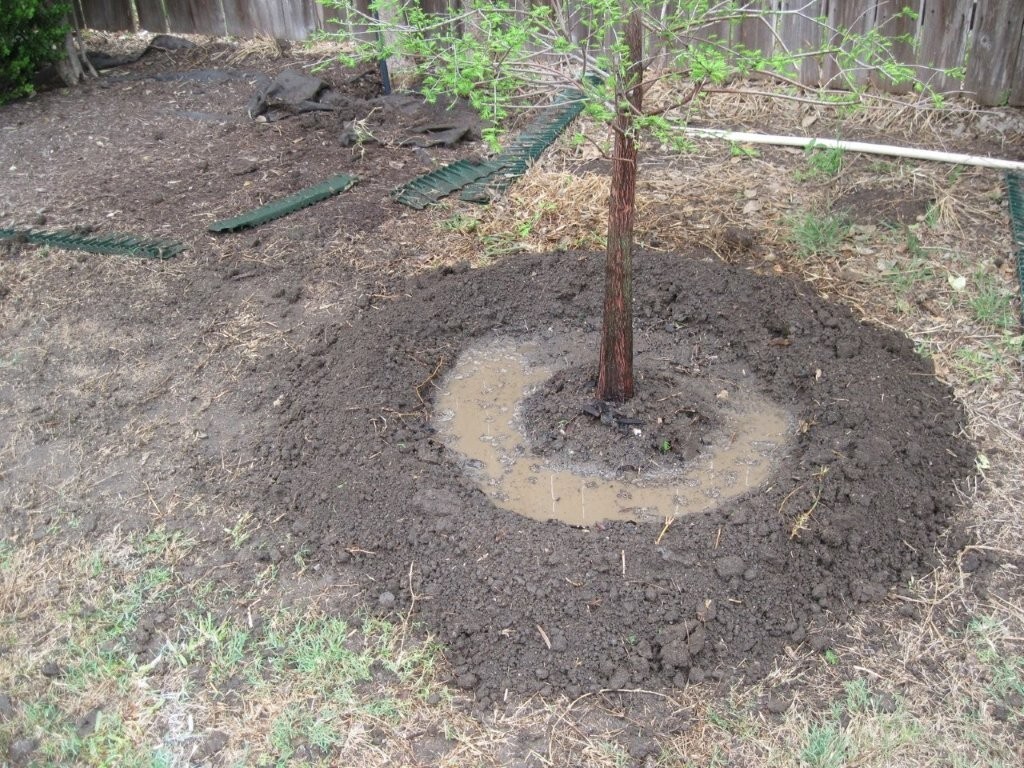Tree Planting and Watering Instructions: Creating a Tree Moat
1. Planting the Tree
-
Choose the Right Location: Ensure the tree has enough space for its mature size, receives appropriate sunlight, and is suited to the soil conditions.
-
Dig the Hole:
-
Make the hole at least 12 inches wider than the root ball, but no deeper than the root ball height.
-
The top of the root flare (where the roots spread from the trunk) should be 2–4 inches above grade to allow for settling of the root ball, when planted.
-
-
Position the Tree:
-
Carefully place the tree in the hole, adjusting for straightness.
-
Backfill halfway with original soil, water lightly to settle soil, then finish filling.
-
2. Creating a Tree Moat
-
Purpose: A tree moat holds water around the root zone to allow for deep, slow soaking — encouraging deep root growth and improving drought resistance.
-
Steps to Create the Moat:
-
After planting and backfilling, use extra soil to form a circular berm (raised ring) around the tree.
-
Size:
-
The moat should be about 2–3 feet away from the trunk in all directions (or the size of the hole dug for the tree).
-
The berm should be 4–6 inches high and wide enough (6–8 inches) to hold water without quickly collapsing.
-
-
Shape: Make the moat like a shallow bowl: higher at the edges and lower toward the tree. ALWAYS KEEP SOIL AWAY FROM THE TRUNK OF THE TREE.
-
Mulch (optional): Apply a 2–4 inch layer of mulch inside the moat, keeping it 3–6 inches away from the trunk to prevent rot
-

3. Watering the Tree Using the Moat
-
Initial Watering:
-
Fill the moat slowly with water immediately after planting, allowing it to soak in completely.
-
Repeat once or twice depending on soil absorption.
-
-
Watering Schedule:
-
First 1–2 Weeks: Water daily or every other day, depending on temperature and soil drainage.
-
Weeks 3–12: Water 1–2 times per week.
-
Beyond 3 Months: Water deeply every 2–4 weeks for the first 1–2 years.
-
Adjust frequency for environmental conditions. Rainfall is not sufficient moisture for newly planted plants.
-
-
How Much Water:
-
Each watering should fill the moat entirely.
-
For young trees, aim for 5–10 gallons per watering.
-
Larger trees may need 20 gallons or more.
-
-
Key Tip: Deep, infrequent watering encourages deep roots; shallow, frequent watering causes weak surface roots and plant damage. Shrubs and trees grown in plastic containers must be totally saturated prior to removing the plant from the pot.
4. Maintaining the Moat
-
Inspect Regularly: Over time, rain or irrigation may erode the berm. Rebuild it as needed to maintain the structure.
-
Adjust as the Tree Grows: Widen the moat gradually as the root system expands outward.
-
Seasonal Adjustments:
-
Reduce watering in cooler months.
-
Increase watering during droughts or heat waves.
-
Planting Guide
Preparation
Install your new plants as soon as possible. If there's a delay, store them in a shady, wind-protected area and keep the root area moist. Always handle plants gently using the container or root ball, never by the stems or leaves. Place them in their preferred environment for best results.
Planting Instructions
Balled and Burlap
Plant with burlap, rope, and wire basket intact. Fill around the ball with a good soil mix up to three-quarters, then water thoroughly. Untie strings from the trunk and fold burlap down out of sight. Amother option is to leave the string and burlap in tact for. the first season, but MUST be cut and removed the second season.
Fibre Pots
Leave the pot on. Break off the rim, make three cuts from the bottom halfway up, and do not remove the pot bottom. Roots will penetrate naturally.
Plastic Pots
Water thoroughly before planting. If the plant doesn't release, make two vertical cuts and peel the pot away. Gently loosen roots and make vertical cuts on matted roots to encourage outward growth.
Perennials and Annuals
Prepare the bed with 3"-6" of peat moss worked into 3"-12" of soil. Add general-purpose flowering fertilizer. If planting individually, prepare each hole accordingly. A granular slow release fertilizer should be applied for the season.
3 Easy Steps to Success
- Plant the tree or shrub no deeper than it grew at the nursery.
- Ensure good drainage, especially in clay soil, by modifying the soil before planting.
- Dig a hole at least 12" larger than the root ball on all sides for soil enrichment.
Mulching
Mulch retains moisture, reduces weeds, keeps roots cool in summer and insulated in winter. Apply a layer after planting for easier maintenance and healthier plants. ALWAYS KEEP THE MULCH AWAY FROM THE TRUNK.
Watering
Plants in plastic pots dry out quickly. Deep watering helps roots grow deeper and become drought-resistant. Make sure you are watering the plant root zone in order for the plant to recieve sufficient water. Water should be penetrating 12 inches deep.
When watering multiple plants, water all plants and repeat the process again to ensure water is reaching the deep root system.
Check soil around the root ball frequently.
Helpful Tips
- Use a high-phosphorus "transplanter" fertilizer when transpanting or planting your trees or shrubs.
- Water evergreens thoroughly in the fall before freeze-up to prevent damage. This will prevent wind damage in the winter months.
- Divert downspouts and sprinklers away from planting areas.
- Water only when soil feels dry 2"-3" deep. Continue until the plant is well-established.
- Ideal soil mix: 50% soil, 25% peat moss, 25% manure.
